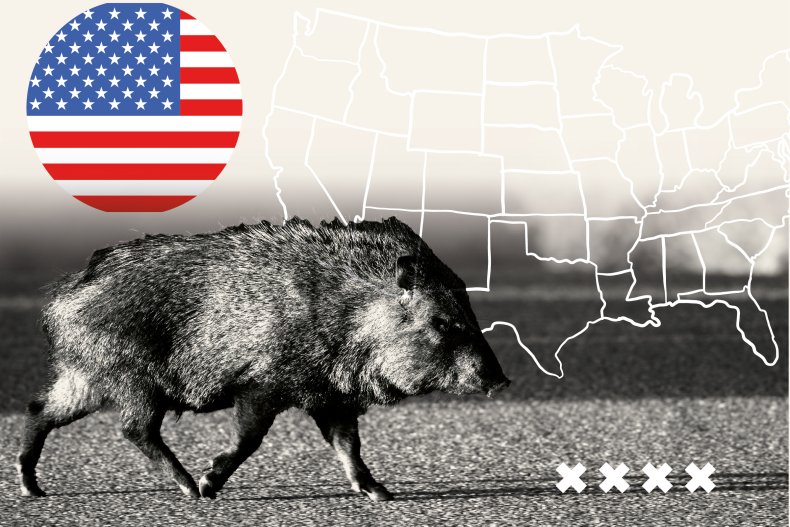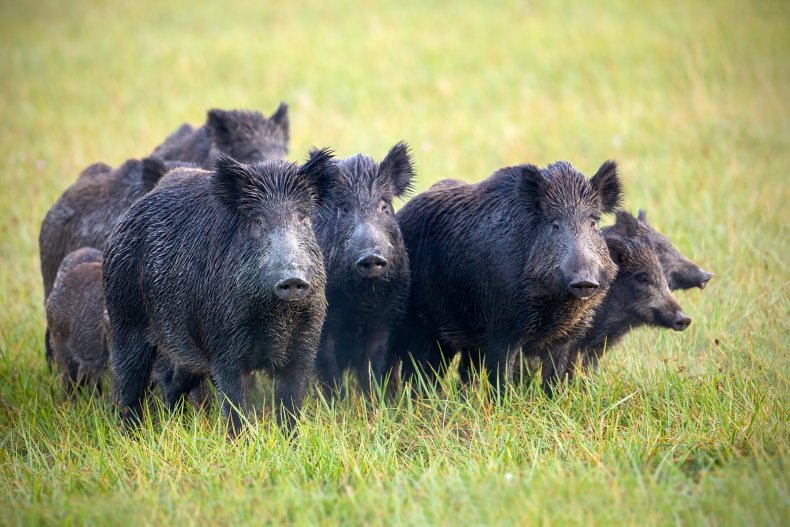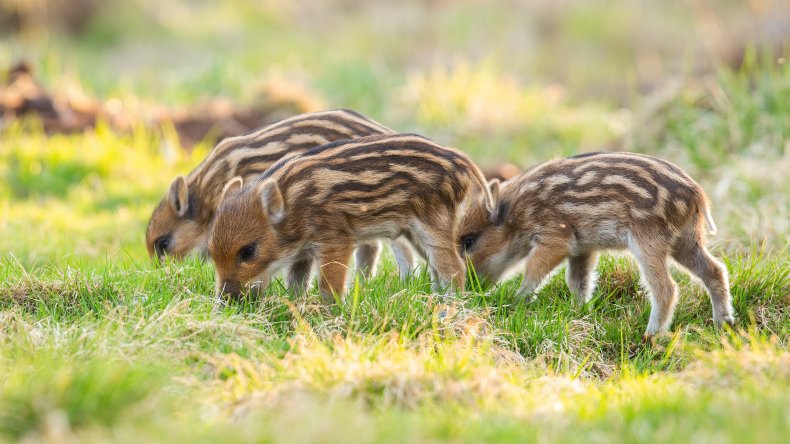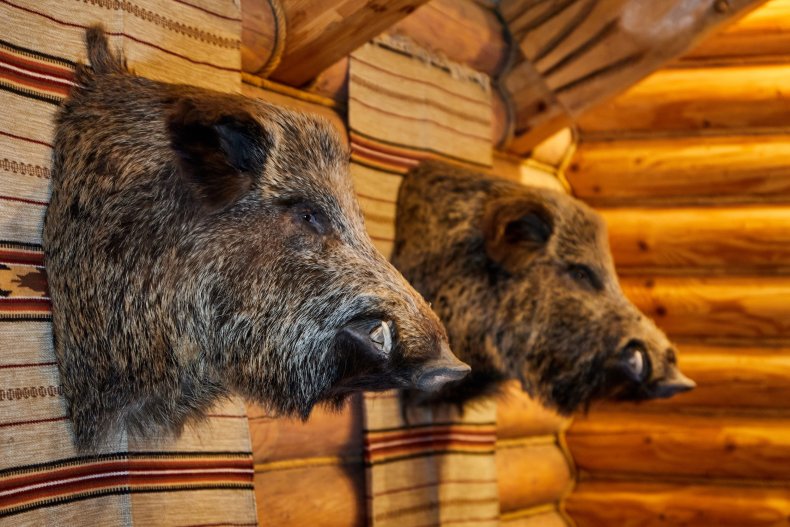Feral pigs have roamed the woods of the U.S. for centuries and are a major feature in the U.S. countryside, with one Twitter user famously going viral in 2020 complaining about the "30-50 feral hogs" that kept disturbing their kids playing in the yard.
It seems that these traditional wild boars have now crossbred with domestic pigs, creating huge hybrid hogs that are descending en masse from Canada into the U.S., primed to cause even greater destruction than usual.
The Guardian reported in February that these so-called "super pigs" that are moving south from Canada are "incredibly intelligent, highly elusive," larger in stature than their cousins, and capable of tunneling into snow to survive in colder climes.

The United States Department of Agriculture (USDA) states the U.S.—having brought feral swine over during the country's colonization in the 1500s—has around 6 million feral swine across at least 31 states. These boars, having lived away from humans for many generations, are now considered an invasive species. They usually weigh 75 pounds to 250 pounds, but can grow even larger.
"Wild pigs are a very successful species because of their generalist diet and habitat preferences, their tolerance of a broad range of climate conditions, and relatively high population growth rate," Jim Hone, an emeritus professor of wildlife ecology and management at the University of Canberra in Australia, told Newsweek.
Wild boars cause damage to farmlands, crops, properties and livestock, digging through fields hunting for food and attacking other animals and their nests.
"The damage wild pigs cause is much the same around the world where they occur - crop damage, livestock (lambs) predation, damage to water holes and fences, and possible spread of disease," Hone said. "Environmental damage includes predation of turtle eggs, to damage of threatened plant species. Hawaii has had some success in fencing out wild pigs from the national park on the big island."
Wild pigs cause lots of damage to U.S. agriculture (estimated to be at least $2.5 billion each year) and also have a widespread impact on biodiversity across the country.
"As a non-native invasive species, they compete and prey on native wildlife, including threatened and endangered plants and animals," Joshua A. Gaskamp, a wildlife and range consultation manager at Noble Research Institute, told Newsweek. "Vehicle collisions are on the rise. And wild pigs carried at least 70 zoonotic diseases transmissible to livestock, humans, or other animals. As populations of wild pigs spread and densities increase across the country, these damages will become more widespread."
The diseases include leptospirosis, toxoplasmosis, brucellosis, swine influenza, salmonella, hepatitis and pathogenic E. coli, according to National Geographic.

So, if these boars are mating with domestic pigs, what kind of an impacts could that have on the U.S.? It depends on the kinds of traits they end up inheriting, including the reproductive rate.
"The European wild boar and the various breeds of domestic swine that live in the United States and Canada are all the same species," Gaskamp said. "Therefore, domesticated and wild-type European wild boars can and do successfully breed."
"The difference between a wild-type (or animal that is genetically closer to a European wild boar) and a domestic pig is the fact that certain traits are more prevalent in various domestic pig breeds after generations of selective breeding to create a desirable animal for market or show," Gaskamp said.
Usually, pig breeders would select traits that would benefit them financially, like high reproductive potential and a rapid growth rate. This only becomes a problem once these highly productive pigs are loose in the wild.

European wild boar generally have one breeding season each year, and produce an average of between three and six pigs per litter. Domestic pigs regularly produce more than eight piglets per litter and do so twice in a single year.
"The reproductive rate of hybridized feral pigs (feral domestics crossed with wild boar) is approximately 6 pigs per litter and 1.5 litters per year per sow on average," Gaskamp said.
"Domestic pigs or domestic crosses weren't designed to be survivors in the wild, although they do pretty well. European wild boar were selected by mother nature so they are designed to survive. There is potential for swine with more domestic genetic expression to be slightly larger, but again, that isn't a trait that will keep a pig alive in the wild."
The Guardian reported that the first crossbreeds in the 1980s were much larger, but also reproduced faster than expected. This may remain true for newer hybrids.
"During the hybridisation time we face always a transfer of characters from one population to another, due to that the wild boars become more prolific, perhaps even less fearful of humans and certainly larger in size," Domenico Fulgione, a professor of population ecology at University of Naples Federico II in Italy, told Newsweek.
Hybridization may not be the only major driver of the spread of the wild pigs, as another is actually humans moving them across the country so that we can hunt them for sport.
"The primary modality that causes the spread of wild pig populations is human transport and release," Gaskamp said. "Wild pigs are fun to hunt, but that is an incentive to have them near you, and further promotes their existence and spread, even where unwanted and in non-native territory. Currently, you can pay the wildlife department in some states for a tag to hunt an invasive wild pig while, in other states, you must call authorities or shoot on sight. Still others allow the trapping and sale of wild pigs for meat consumption, yet another incentive to keep them around."

As the populations increase in the near future, either due to the hybrid pigs or other reasons, then the U.S. food web may end up changing.
"All animal species live in a sort of dynamic equilibrium, the disruption of this balance affects other species," Fulgione said.
"In Europe, for example, due to a considerable increase in wild boars, we have observed a significant increase of its predators, the wolves, but an increase also in some kind of scavengers such as jackals. Even predators, if in large numbers, are difficult to manage and make compatible with agriculture and animal husbandry."
Handling the population of wild pigs and limiting the damage that they do to the U.S. economy and ecosystems requires careful planning and efficient management.
"Wildlife management should be a shared policy. We can't go on with different policies from state to state, animals do not know national borders," Fulgione said.
Therefore, the pigs and their movements must be properly studied before implementing a control strategy that spans all the affected states.
"To curtail this invasion, communities, states, and the national government need to have a consistent message about the nuisance species and a consistent management plan," Gaskamp said. "In addition to a consistent plan or strategy across a large geography, landowners can be working together to keep wild pigs off of their farms. We can make larger, longer lasting impacts if we work together across larger geographies."
Do you have an animal or nature story to share with Newsweek? Do you have a question about wild boars? Let us know via science@newsweek.com.
"about" - Google News
March 18, 2023 at 02:00PM
https://ift.tt/hZVFb8O
America's Feral Hog Problem Is About to Get Even Worse - Newsweek
"about" - Google News
https://ift.tt/D7m5feq
Bagikan Berita Ini














0 Response to "America's Feral Hog Problem Is About to Get Even Worse - Newsweek"
Post a Comment